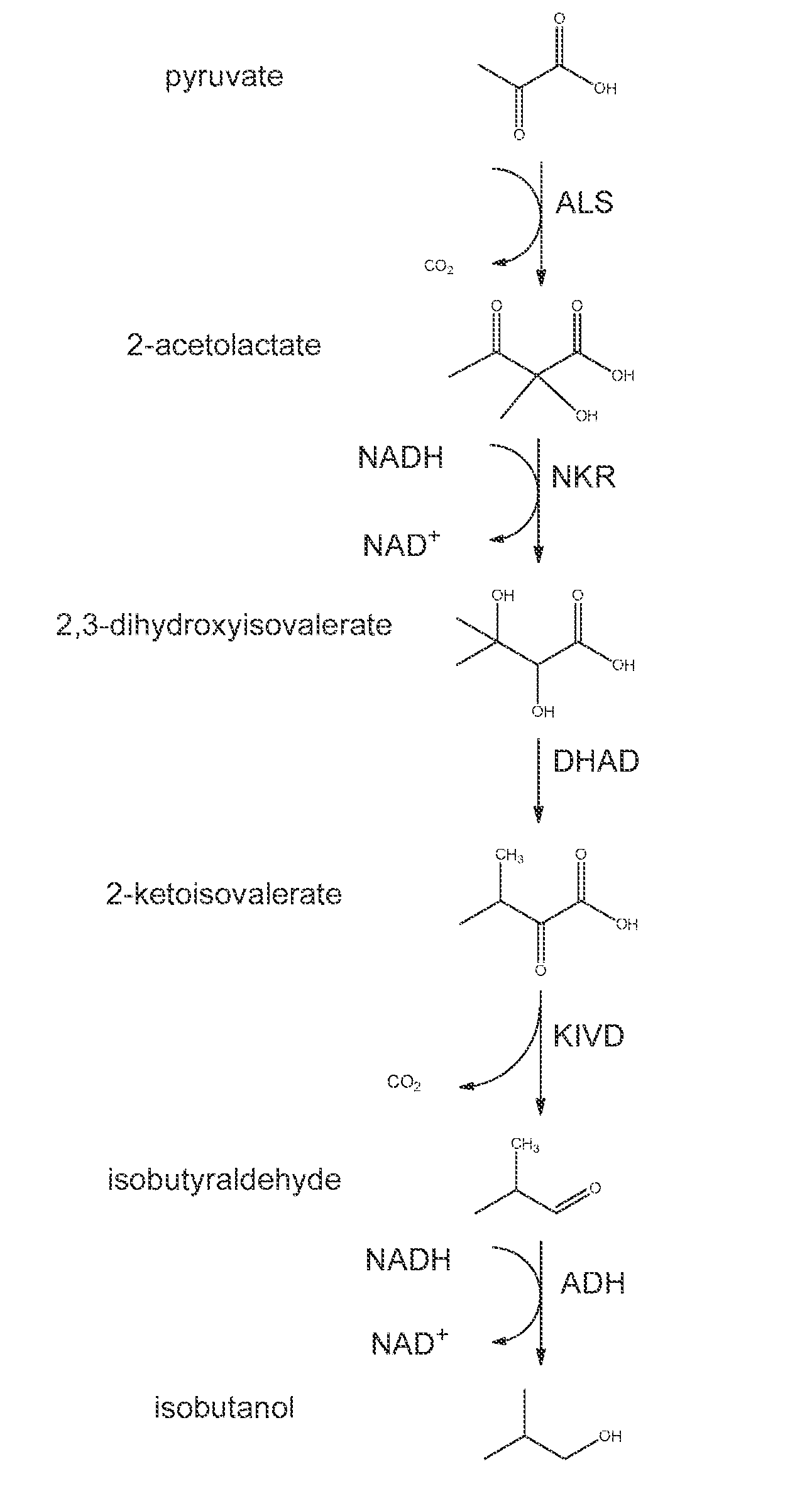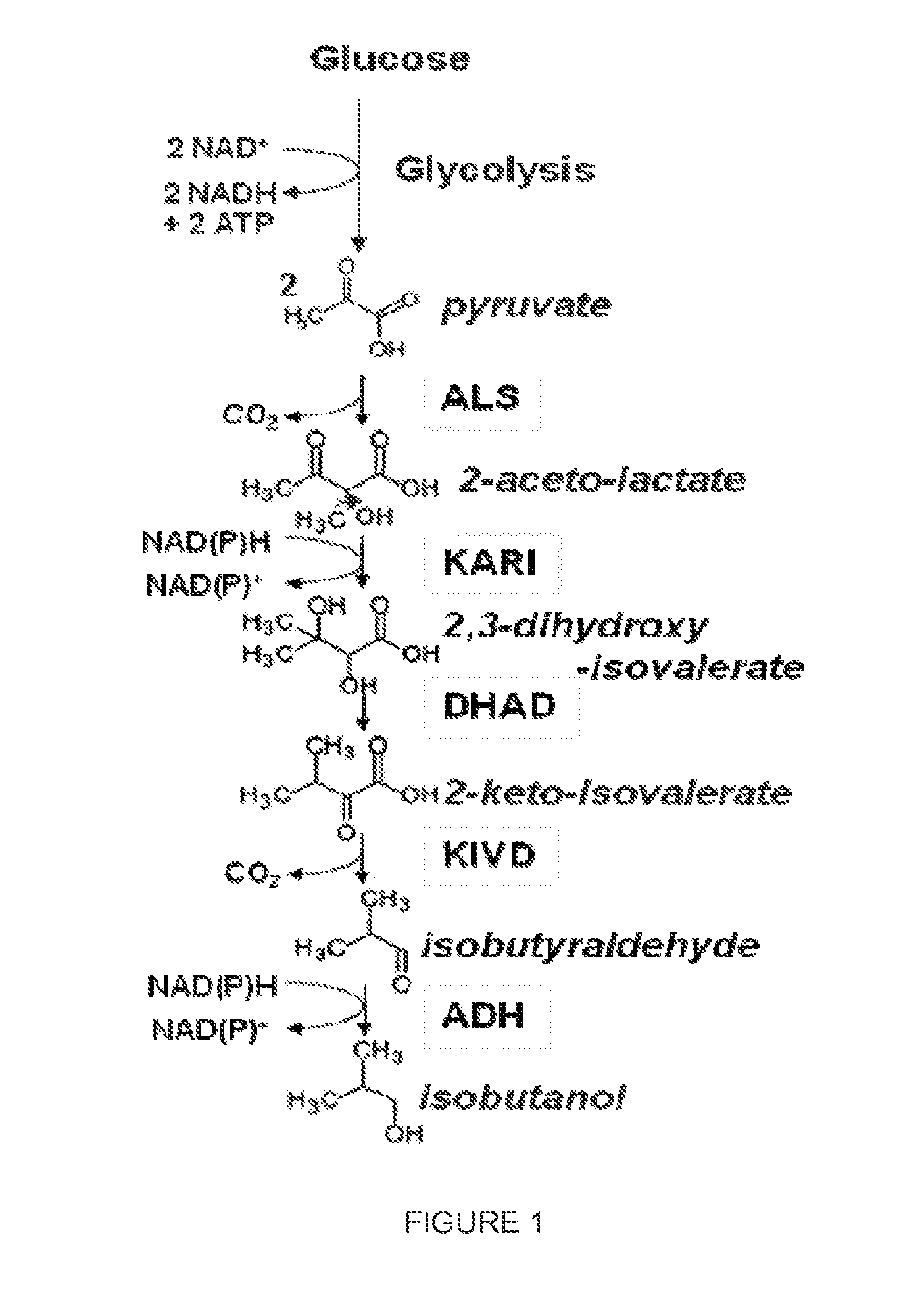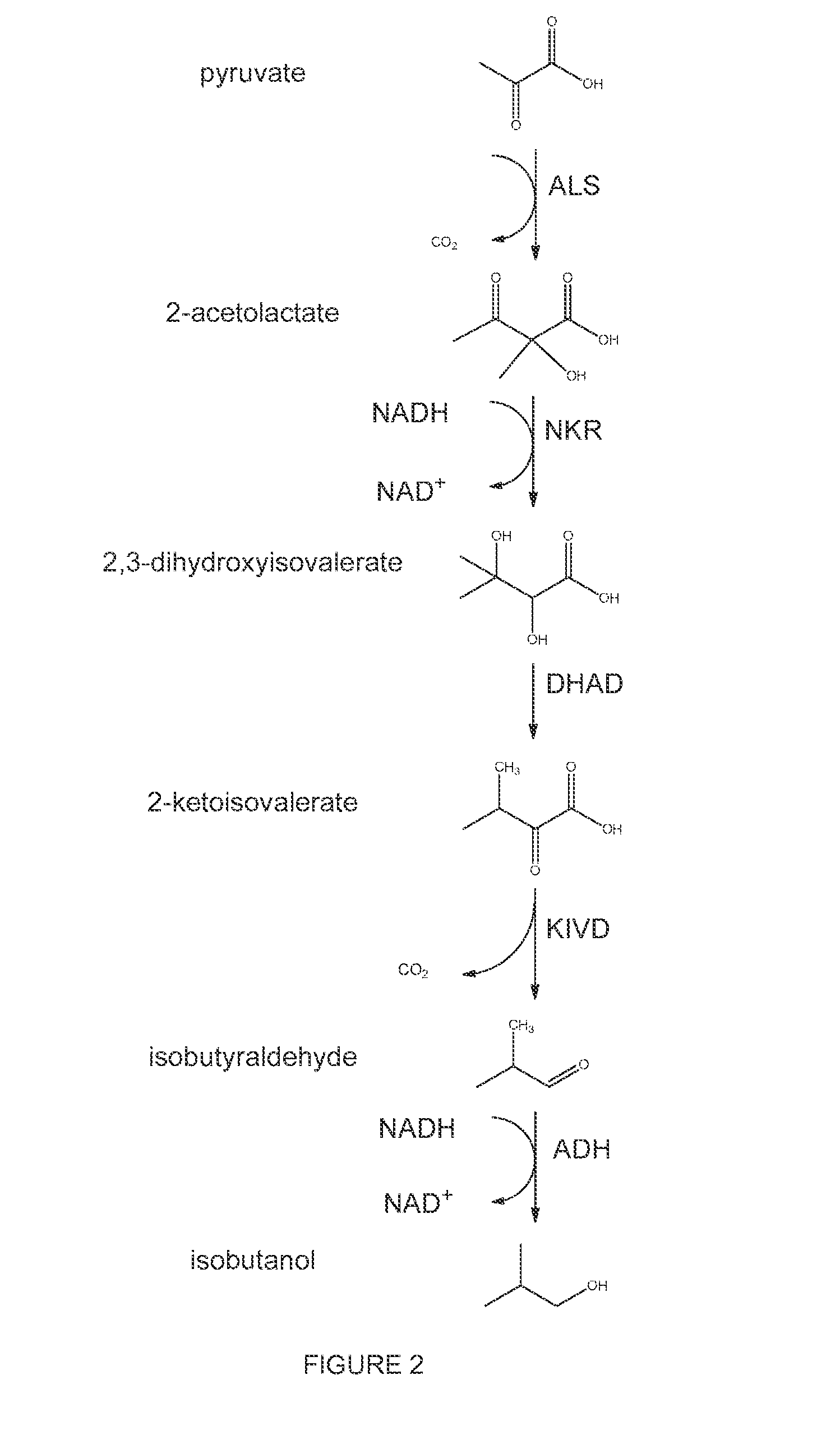High-Performance Ketol-Acid Reductoisomerases
a reductoisomerase, high-performance technology, applied in the direction of biofuels, microorganisms, enzymes, etc., can solve the problems of low performance characteristics and shorten the commercial relevance of microorganisms produced to date, and achieve the effect of improving the production of isobutanol and high activity
- Summary
- Abstract
- Description
- Claims
- Application Information
AI Technical Summary
Benefits of technology
Problems solved by technology
Method used
Image
Examples
example 1
Materials and Methods for Example 1
[0225]
TABLE 2Strain Used in Examples 1-2.GEVO3956MATa ura3 leu2 his3 trp1 ald6::PENO2-LI_adhARE1 -PFBA1-Sc_TRP1gpd1::TKI_URA3 gpd2::TKI_URA3 tma29::TKI_URA3 pdc1::PPDC1-LI_kivD2_coSc5-PFBA1-LEU2-TLEU2-PADH1-Bs_alsS1_coSc-TCYC1-PPGK1-LI_kivD2_coEc-PENO2-Sp_HIS5 pdc5::TKI_URA3pdc6::PTDH3-Sc_AFT1-PENO2-LI_adhARE1-T-KI_URA3_short-PFBA1-KI_URA3-TKI_URA3
TABLE 3Plasmid Used in Example 1-2.pGV3009PSc_TEF1:LI_ilvD_coSc:TSc_ADH1, PSc_PDC1-350:EC_ilvC_coScP2D1_A1_his6,PSc_TPI1:G418R,PSc_ENO2:LI_adhARE1,CEN / ARS origin of replication,ApR, pMB1 origin of replication
[0226]In this example, a series of KARI genes were individually expressed from a yeast promoter in conjunction with other components of an isobutanol production pathway in yeast such that KARI was the limiting enzyme in the pathway and the amount of isobutanol produced during a fermentation was dependent on the KARI activity level. In this system, the S. cerevisiae host strain GEV03956, which expresse...
example 2
[0235]The purpose of this example is to show how additional high-performance KARIs were identified.
[0236]In this example, a series of KARI genes were individually expressed from a yeast promoter in conjunction with other components of an isobutanol production pathway in yeast such that KARI was the limiting enzyme in the pathway and the amount of isobutanol produced during a fermentation was dependent on the KARI activity level. In this system, the S. cerevisiae host strain GEV03956, which expresses ALS and KIVD enzymes, was used to produce isobutanol when supplied with a low copy number plasmid expressing KARI, DHAD, and ADH enzymes.
[0237]KARIs were identified and grouped by bioinformatic and phylogenetic methods based on the amino acid sequence. Individual KARIs were chosen for the above analysis to provide a representative sample of broadly diverse clades. KARI genes were designed and synthesized based on the primary amino acid sequence of the chosen KARI, with codon optimization...
example 3
Materials and Methods for Example 3
[0251]
TABLE 9Strains Used in Example 3.StrainGenotype / SourceE. coliF− ompT gal dcm lon hsdSB(rB−mB−) λ (DE3BL21 (DE3)[lacI lacUV5-T7 gene 1 ind1 sam7 nin5]
TABLE 10Plasmids Used in Example 3.PlasmidGenotypepET22b(+)PT7, bla, ori pBR322, lacI, C-term 6xHispET[ilvC]PT7::Ec_ilvC_coEchis6, bla, oripBR322, lacIpGV3281PT7::LI_KARI_coSchis6, bla, oripBR322, lacIpETLI1A9PT7::LI_KARI1A9_coSchis6, bla, opripBR322, lacIpETLI1G2PT7::LI_KARI1G2_coSchis6, bla, oripBR322, lacIpETLI1C2PT7::LI_KARI1C2_coSchis6, bla, oripBR322, lacIpETLI1G5PT7::LI_KARI1G5_coSchis6, bla, oripBR322, lacIpETLI4H8PT7::LI_KARI4H8_coSchis6, bla, oripBR322, lacIpETLI3C7PT7::LI_KARI3C7_coSchis6, bla, oripBR322, lacIpETLINKRGen6aPT7::LI_NKRGen6a_coSchis6, bla, oripBR322, lacIpETLINKRGen6bPT7::LI_NKRGen6b_coSchis6, bla, oripBR322, lacI
TABLE 11Primers Used in Example 3.#Primer nameSequence1T7_forTAATACGACTCACTATAGGG (SEQ ID NO: 91)2T7_revGCTAGTTATTGCTCAGCGG (SEQ ID NO: 92)3LIKARI_Y26NNK_forATC...
PUM
| Property | Measurement | Unit |
|---|---|---|
| pH | aaaaa | aaaaa |
| pH | aaaaa | aaaaa |
| length | aaaaa | aaaaa |
Abstract
Description
Claims
Application Information
 Login to View More
Login to View More - R&D
- Intellectual Property
- Life Sciences
- Materials
- Tech Scout
- Unparalleled Data Quality
- Higher Quality Content
- 60% Fewer Hallucinations
Browse by: Latest US Patents, China's latest patents, Technical Efficacy Thesaurus, Application Domain, Technology Topic, Popular Technical Reports.
© 2025 PatSnap. All rights reserved.Legal|Privacy policy|Modern Slavery Act Transparency Statement|Sitemap|About US| Contact US: help@patsnap.com



